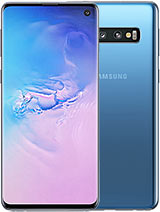Samsung Galaxy S10 Radiation Levels
[add_sar_ranking_update]
Galaxy S10
| Select a phone to compare Galaxy S10 SAR levels to other popular phones |
| Cell Phone Usage & Radiation Exposure | ||||||||||||
Samsung Galaxy S10 Safety Tip:How Much Will Turning Off Wi-Fi and Bluetooth Reduce Radiation?This SAR chart reveals how turning off Wi-Fi and Bluetooth on your Samsung Galaxy S10 can significantly reduce your exposure to radiation. Our SAR comparison chart shows that by simply turning off Wi-Fi and Bluetooth transmitters, you can lower the RF radiation exposure to your head by %, and you can lower exposure to the body by %, when considering these differences between cellular-only (Wi-Fi/Bluetooth OFF) and simultaneous use exposure (Wi-Fi/Bluetooth ON), a wise way to reduce excessive phone radiation is to tap off unnecessary transmitters when not in use! Additionally, when using your phone as a hotspot, turning off Bluetooth can reduce your exposure by up to % according to the FCC SAR report for device number A3LSMG973U. Samsung Galaxy S10 SAR Levels
|
Key Takeaways
- Children vs Adults: Children have higher SAR levels due to thinner skulls and developing tissues, making them more vulnerable to radiation.
- Wi-Fi Impact: Simultaneous use of cellular and Wi-Fi transmission increases SAR levels for all age groups.
- Precautionary Measures: Using radiation protection products like QuantaCase can help mitigate these risks, especially for younger users.
By understanding these differences, parents and guardians can make informed decisions to better protect their children from excessive microwave radiation exposure, emphasizing the need for safer smartphone usage practices and protective accessories like QuantaCase.

| Children vs Adults Radiation Exposure |
The Specific Absorption Rate (SAR) of a mobile device measures the amount of radio frequency energy absorbed by the body during device usage.
The SAR values for the galaxy-s10 (FCC ID A3LSMG973U) are as follows:
- 0.39 W/kg when held at the head with cellular transmission only
- 1.37 W/kg when worn on the body with cellular transmission only
- 0 W/kg when used as a Hotspot or Airplay
- 0 W/kg when held at the head with simultaneous cellular and Wi-Fi transmission
- 0 W/kg when worn on the body with simultaneous cellular and Wi-Fi transmission
- when used as a Hotspot simultaneously with other transmitters active.
Samsung Galaxy S10 - SAR Levels
FCC SAR Levels
- FCC Approval Date This is the date the phone SAR test was completed before the phone's release to the public as required by law. 01 February 2019
- FCC ID The FCC ID is the code used to register a device for FCC compliance A3LSMG973U
- FCC Report Link A direct link to the FCC's website for confirming SAR levels that are listed on our website - We did the homework for you!
- US SAR Ratings USA Legal Limit is 1.6 W/kg USA Legal Limit is 1.6 W/kg - FCC SAR testing is measured in watts per kilogram (or W/kg) averaged over ONE gram of simulated biological tissue.
- Head SAR Level SAR test when held against your head when only using cellular service. Wifi and other transmitter are NOT active 0.39 W/kg
- Body SAR Level SAR test when held against your body only using cellular service. Wifi and other transmitter are NOT active 1.37 W/kg
- Simultaneous Transmission The highest possible SAR recorded with ALL transmitters active, Cellular, WiFi, and Hotspot 1.59 W/kg
- Hotspot SAR The highest possible SAR test when held against your BODY using the phone as a hotspot with cellular and WiFi transmitters active, 1.35 W/kg
EU SAR Level
- EU SAR Ratings European Legal Limit is 2.0 W/kg - EU SAR testing is measured in watts per kilogram (or W/kg) averaged over TEN grams of simulated biological tissue.
- Head SAR Level N/A
- Body SAR Level N/A
Samsung Galaxy S10 SAR test reports filed with the Federal Communications Commission FCCID A3LSMG973U — the Specific Absorption Rate (SAR) Samsung Galaxy S10 is 0.39 watts per kilogram (w/kg) at your head, and 1.37 W/kg when worn on your body. The Samsung Galaxy S10 hotspot SAR is 1.35 W/kg and its SAR for simultaneous transmission (cellular plus Wi-Fi) is 1.59 W/kg when used as a hotspot simultaneously with other transmitters active.
| Network | Technology | GSM / CDMA / HSPA / EVDO / LTE |
|---|---|---|
| 2G bands | GSM 850 / 900 / 1800 / 1900 – SIM 1 & SIM 2 (dual-SIM model only) | |
| CDMA 800 / 1900 – USA | ||
| 3G bands | HSDPA 850 / 900 / 1700(AWS) / 1900 / 2100 – Global, USA | |
| CDMA2000 1xEV-DO – USA | ||
| 4G bands | LTE band 1(2100), 2(1900), 3(1800), 4(1700/2100), 5(850), 7(2600), 8(900), 12(700), 13(700), 17(700), 18(800), 19(800), 20(800), 25(1900), 26(850), 28(700), 32(1500), 38(2600), 39(1900), 40(2300), 41(2500), 66(1700/2100) – Global | |
| LTE band 1(2100), 2(1900), 3(1800), 4(1700/2100), 5(850), 7(2600), 8(900), 12(700), 13(700), 14(700), 17(700), 18(800), 19(800), 20(800), 25(1900), 26(850), 28(700), 29(700), 30(2300), 38(2600), 39(1900), 40(2300), 41(2500), 46, 66(1700/2100), 71(600) – USA | ||
| Speed | HSPA 42.2/5.76 Mbps, LTE-A (7CA) Cat20 2000/150 Mbps | |
| GPRS | Yes | |
| EDGE | Yes |
| Launch | Announced | 2019, February |
|---|---|---|
| Status | Coming soon. Exp. release 2019, March 8 |
| Body | Dimensions | 149.9 x 70.4 x 7.8 mm (5.90 x 2.77 x 0.31 in) |
|---|---|---|
| Weight | 157 g (5.54 oz) | |
| Build | Back glass (Gorilla Glass 5), aluminum frame | |
| SIM | Single SIM (Nano-SIM) or Hybrid Dual SIM (Nano-SIM, dual stand-by) | |
| – Samsung Pay (Visa, MasterCard certified) – IP68 dust/water proof (up to 1.5m for 30 mins) |
| Display | Type | Dynamic AMOLED capacitive touchscreen, 16M colors |
|---|---|---|
| Size | 6.1 inches, 93.2 cm2 (~88.3% screen-to-body ratio) | |
| Resolution | 1440 x 3040 pixels, 19:9 ratio (~550 ppi density) | |
| Protection | Corning Gorilla Glass 6 | |
| – HDR10+ – Always-on display |
| Platform | OS | Android 9.0 (Pie); One UI |
|---|---|---|
| Chipset | Exynos 9820 Octa (8 nm) – EMEA Qualcomm SDM855 Snapdragon 855 (7 nm) – USA/LATAM, China | |
| CPU | Octa-core (2×2.73 GHz Mongoose M4 & 2×2.31 GHz Cortex-A75 & 4×1.95 GHz Cortex-A55) – EMEA Octa-core (1×2.84 GHz Kryo 485 & 3×2.41 GHz Kryo 485 & 4×1.78 GHz Kryo 485) – USA/LATAM, China | |
| GPU | Mali-G76 MP12 – EMEA Adreno 640 – USA/LATAM, China |
| Memory | Card slot | microSD, up to 512 GB (uses SIM 2 slot) – dual SIM model only |
|---|---|---|
| Internal | 128/512 GB, 8 GB RAM |
| Main Camera | Triple | 12 MP, f/1.5-2.4, 26mm (wide), 1/2.55″, 1.4m, Dual Pixel PDAF, OIS 12 MP, f/2.4, 52mm (telephoto), 1/3.6″, 1.0m, AF, OIS, 2x optical zoom 16 MP, f/2.2, 12mm (ultrawide), 1.0m |
|---|---|---|
| Features | LED flash, auto-HDR, panorama | |
| Video | 2160p@60fps, 1080p@240fps, 720p@960fps, HDR, dual-video rec. |
| Selfie camera | Single | 10 MP, f/1.9, 26mm (wide), 1.22m, Dual Pixel PDAF |
|---|---|---|
| Features | Dual video call, Auto-HDR | |
| Video | 2160p@30fps, 1080p@30fps |
| Sound | Loudspeaker | Yes, with stereo speakers |
|---|---|---|
| 3.5mm jack | Yes | |
| – 32-bit/384kHz audio – Active noise cancellation with dedicated mic – Dolby Atmos/AKG sound |
| Comms | WLAN | Wi-Fi 802.11 a/b/g/n/ac/ax, dual-band, Wi-Fi Direct, hotspot |
|---|---|---|
| Bluetooth | 5.0, A2DP, LE, aptX | |
| GPS | Yes, with A-GPS, GLONASS, BDS, GALILEO | |
| NFC | Yes | |
| Radio | FM radio (USA & Canada only) | |
| USB | 3.1, Type-C 1.0 reversible connector |
| Features | Sensors | Fingerprint (under display), accelerometer, gyro, proximity, compass, barometer, heart rate, SpO2 |
|---|---|---|
| – ANT+ – Bixby natural language commands and dictation – Samsung DeX (desktop experience support) |
| Battery | Non-removable Li-Ion 3400 mAh battery | |
|---|---|---|
| Charging | Fast battery charging 15W Fast wireless charging 15W Power bank/Reverse wireless charging 9W |
| Misc | Colors | Prism White, Prism Black, Prism Green, Prism Blue, Canary Yellow, Flamingo Pink |
|---|---|---|
| Price | About 930 EUR |









